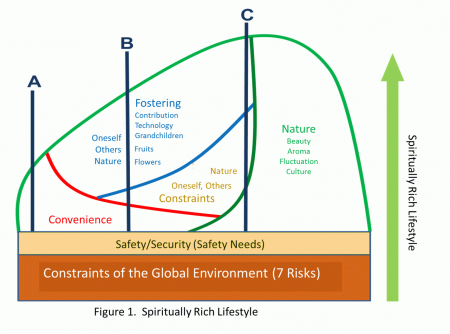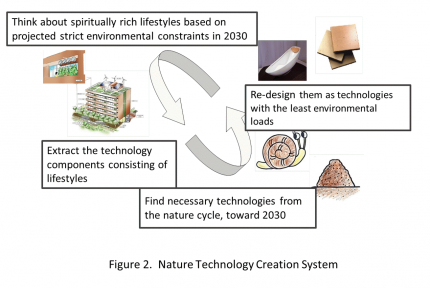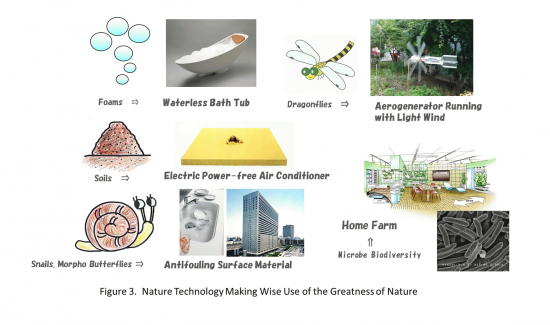Nature Technology - New Manufacturing Technology and Lifestyles Making Wise Use of the Greatness of Nature
- Hideki Ishida
- Professor Emeritus, Tohoku University
Representative of the Earth Village Research Lab. LLC
1. Thinking About the Shape of Richness
What is the role of technologies (administrations, business, NGOs/NPOs) in the first place? Their role is definitely to enrich people. It's not an exaggeration to say that is the sole purpose of technologies. In addition, what many people want is spiritual richness. In Japan, spiritual richness has been more in demand than material richness since the 1980s, and the gap between the two is heading toward more than 30 percentage points.
Therefore, can technology contribute to the spiritual richness objective? Unfortunately, as the growth in GDP per capita rises, both the level of happiness and level of life satisfaction are declining little by little, rather than rising. And everyone already knows that richness will not be brought by the same formula as past richness derived from the wanton waste of resources and energy. In fact, we will trigger the collapse of civilization if we continue to walk down this road.
Then, where should we go? At least, we cannot be able to find any solution as an extension of the past. We must prepare a new foothold in order to find a new spiritually rich lifestyle with limited energy and resources. What is needed is not adding something, but drastically changing the foothold.
2. Where Should We Go From Here?
Nobody doubts that the global environmental problems are urgent issues. But these days it is increasingly obvious that eco technologies encounter a dilemma which accelerates consumption and environmental deterioration. Eco technologies are functioning as an excuse for consumption although they may take the global environment into consideration.
Then, are eco technologies evil? Of course not. Eco technologies have warned us about those technologies seeking comfort and convenience through the wanton waste of global resources, and have generated environmental awareness in the minds of about 90% of the Japanese people. Nevertheless, environmental deterioration has not been controlled because these eco technologies are just replacement technologies. Without changing the structure of mass production and mass consumption, the technologies bearing the name of “eco” continue to pose a dilemma, and eventually, will make just a small contribution in terms of halting the deterioration of the global environment. However, the achievement of these eco technologies is still notably great as it has changed the minds of 90% of the Japanese people. But nothing would be solved as long as we stay the same. We must step forward. Eco technologies are one process of selection, and further selections are necessary in order to change our lifestyles.
Then, can we change our lifestyles? Unfortunately, this will not be easy. The solutions will not be found in the extension of the past (forecast thinking). We need new methods thinking about richness within the constraints of the global environment (backcast thinking).
3. Spiritually Rich Lifestyle
A “spiritually rich lifestyle” is finally being derived, based on the analysis of social acceptability and crown-jewel key words collected from the interview survey of people in their nineties* who know about the lifestyle before the World War II. In other words, people are raised under “constraints” (Figure 1).
*Tohoku University has conducted an interview survey of people in their nineties in order to extract from their wisdom and, through recording their valuable experiences, apply this to our new lifestyles.
This spiritually rich lifestyle is, of course, based on projected strict environmental constraints in 2030. Two of these components are “convenience” and “nature.” And the third component is “fostering.” The value of “fostering” is to feel contentment or accomplishment through enjoyment in fostering people and nature. And the spiritual richness increases from A, B to C. For example, “eco” air conditioners are eco-friendly but only have the function of convenience: therefore, the air conditioners are categorized in A. We would be glad when buying something, but we will be tired of it soon. This also means a very short lifespan for commercial use. What’s needed now is the technologies or services categorized in B or C.
Unfortunately, present technologies and services only replace “constraints” for convenience. They do not accept any inconvenience, even if the constraints are positive and could be overcome by making the best use of knowledge or rationality. If the constraints are replaced by convenience, the quality of a spiritually rich lifestyle deteriorates drastically. In Japan, “young people with low materialistic obsession” are in the headlines and many critics make comments on this topic. But it is fact that the things that young people want are not provided in the marketplace by corporations.
4. Encourage Innovation for Manufacturing and New Lifestyle Based on Nature
Technological innovation based on lifestyles means making a break with technologies based on extracting underground resources. Nature is an intelligent force which has its own ethics. Nature has repeated selections over the past 4.6 billion years of the earth’s history and 3.8 billion years of human history, and drives a perfect cycle mainly using only solar energy. We can learn mechanisms, systems and even sociality – so-called “selection” – from nature. At least developed countries have made efforts to construct a sustainable society since the Earth Summit in 1992. However, the ideal is more becoming far removed from the reality. It is now time to work out a spiritually rich lifestyle under the constraints of global environment by using backcast thinking, extracting necessary technologies, looking for them in nature, re-designing them based on sustainability, and creating new technologies. That is a technology creation system through nature technology.
In addition, we need to have another important perspective in thinking about nature technology. We must recognize that most of the present technologies were brought by the Industrial Revolution in the 18th century in Britain. The Industrial Revolution achieved success by breaking away from nature. It produced the concept of mass production and mass consumption, and as a result, it also caused the global environmental problems of today.
Therefore, can nature technology not breaking away from nature really contribute to the construction of a sustainable society? Let’s look back at history. There were people who maintained the original concept of nature under the circumstances dominated by the British Industrial Revolution, and promoted an original industrial revolution. Those were Japanese people in the Edo Era. The Industrial Revolution in Britain was promoted based on the intensification of capital. On the other hand, industrial revolution in Japan was achieved by labor intensification. This created not mass production and mass consumption but technologies producing pleasure or entertainment. On the one hand, the British Industrial Revolution created technology which enhanced materialistic obsessions. On the other, the industrial revolution in Japan created the concept of “iki (意気),” mettle or wit in English. In this sense, it could be said that nature technology is technology which copies the concept of iki, based on nature.
5. Nature Technology Making Wise Use of the Greatness of Nature
Now, nature technology’s creating system has started producing some concrete technologies (Figure 2): including a waterless bath tub, an electric power free air conditioner, an antifouling surface material, an aerogenerator running with light wind, and a home farm. These concise and clear technologies based on nature enhance communications and affection (Figure 3).
Of course, we still face a lot of challenges: How can we extract the technology components from our lifestyles? How do we re-design them without producing environmental loads? At least, we have to start with important steps, as soon as possible. We have to show a new lifestyle and hand it over to future generations. We will be able to enjoy the thrill of finding it and live spiritually in rich harmony with nature.Waterless Bath Tub:
Waterless Bath Tub:
The “Waterless bath tub” needs only about 3-6 liters water when bathing. This idea is based on the foams made by Froghopper larva. Foams retaining heat warm the human body, and clean it with sonication when the foams destruct. This bath tub is also good for old or handicapped people as there is no water pressure.
Electric Power-free Air Conditioner:
This features floor or wall materials inspired by termitariums found in savanna land. The material has nanometer-size pores which condition moisture and automatically keep the air moisture content at a comfortable level (40-70 C).
Antifouling Surface Material:
The surface of morpho butterfly wings can shed water or fouling by their hydrophobic microstructure. Water or fouling runs down along the bosses on the wings. The antifouling surface material inspired by this structure is used for the surface of kitchen sinks or exterior walls of buildings.
Aerogenerator Running with Light Wind:
When a dragonfly flies, a tiny eddy arises on the concavo-convex surface of the wings. This tiny eddy enhances smooth air flow, and the dragonfly’s wings can have lift force even when the wind blows very slightly. This aerogenerator is inspired by the concavo-convex surface of dragonfly wings.
Home Farm
Diversity of soil microbes is the key for rich farmlands. If we can make a medium that can sustain diversity of soil microbes, we can realize “home farms” making the best use of small spaces or walls in houses without using herbicides or fertilizers.
References
Emile H. Ishida, Ryuzo Furukawa, Nature Technology, Creating a Fresh Approach to Technology and Lifestyle, Springer (2014)
Emile H. Ishida (Editorial Supervisor), “Cho-noryoku wo motsu ikimonotachi (in Japanese) (Living Things Having “Super” Natural Power),”Gakken (2014)
Emile H. Ishida and Ryuzo Furukawa (Editorial Supervisors), “2030 nen no Lifestyle ga oshietekureru kokoroyutakana business (in Japanese) (Spiritually Rich Business to be Taught by the Lifestyle in 2030)”, Nikkan Kogyo Shimbun Ltd. (2013)
Emile H. Ishida and Ryuzo Furukawa, “Shizenkai wa technology no hoko (in Japanese) (Nature is Filled with Ideas for Technologies),” Gijutsu-Hyohron Co., Ltd. (2013)
Emile H. Ishida and Tetsu Sato (Editorial Supervisors), “90 sai hearing no susume (in Japanese) (Recommendation for Hearings from People in Their Nineties)”, Nikkei Business Publications, Inc. (2012)
Emile H. Ishida and Masatsugu Shimomura (Editorial Supervisors), “Shizen ni manabu, nature technology (in Japanese) (Learning from Nature: Nature Technology),”Gakken (2011)
Emile H. Ishida (Editorial Supervisor), “Yamori no yubi kara fushigi na tape (in Japanese) (A Wonderful Tape from a Gecko’s Finger), Alicekan (2011)
Emile H. Ishida and Ryuzo Furukawa, “Kimi ga otona ni naru koro ni (in Japanese) (For the Time When You Become an Adult),” Nikkan Kogyo Shimbun Ltd. (2010)
Emile H. Ishida, “Shizen ni manabu iki na technology (in Japanese) (Smart Technology Learning from Nature),”Kagakudojin (2009)
Related Websites
Channeling the Forces of Nature for the Creation of Innovative Life Style
Technologies to Save the Earth – Learning from Nature
Profile of Hideki Ishida
Prof. Ishida was engaged in research as Professor of Tohoku University from 2004 to 2013 after serving as Board Director and CTO of INAX Corporation (now known as LIXIL Corporation). He has subsequently been serving as Representative of the Earth Village Research Lab. LLC with the title of Professor Emeritus designated by Tohoku University. Since 2004, he has proposed “Nature Technology,” making wise use of the greatness of nature, and has actively made efforts for the capacity building of adult students who can devise multi-disciplinary environmental strategies, implement policies and undertake environmental education for children. He also serves, amongst others, as Representative of the Society for Nature Technology, Chairperson of Sustainable Solutions, Board Member of the Manufacturing, Life and Civilization Organization and Vice Chairperson of Earthwatch Japan.
Prof. Ishida’s recent books include: Nature Technology (Springer, 2014), “Cho-noryoku wo motsu ikimonotachi (in Japanese) (Living Things Having “Super” Natural Power)” (Gakken, 2014), “Sore wa eco machigai? (in Japanese) (Is That an “Eco” Mistake?)” (Press Art, 2013), “Shizenkai wa technology no hoko (in Japanese) (Nature is Filled with Ideas for Technologies)” (Gijutsu-Hyohron Co., Ltd., 2013), “Yamori no yubi kara fushigi na tape (in Japanese) (A Wonderful Tape from a Gecko’s Finger)” (Alicekan, 2011), “Mirai no hatarakikata wo design shiyo (in Japanese) (Let’s design how to work in the future)” (Nikkan Kogyo Shimbun Ltd., 2011), “Shizen ni manabu, nature technology (in Japanese) (Learning from Nature: Nature Technology)” (Gakken, 2011), “Kimi ga otona ni naru koro ni (in Japanese) (For the Time When You Become an Adult)” (Nikkan Kogyo Shimbun Ltd., 2010), “Chikyu ga oshieru kiseki no gijyutsu (in Japanese) (Miracle Technology taught by the Earth)” (Shodensya Co. Ltd., 2010) and “Shizen ni manabu iki na technology (in Japanese) (Smart Technology Learning from Nature)” (Kagakudojin, 2009).













